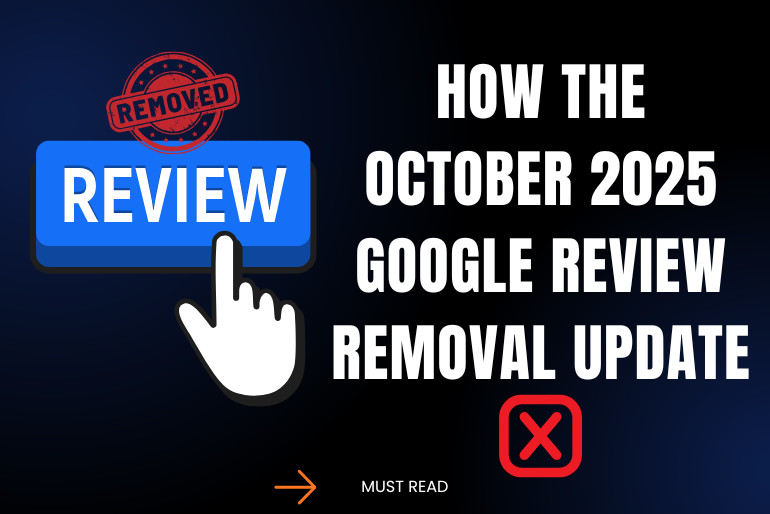In late October 2025, many business owners began reporting sudden drops in their review counts on Google. While Google has not published a detailed announcement, the signals are clear: something is changing in how Google treats, displays, and removes reviews from business profiles.
If you run a local business, or you handle digital marketing for one, this shift is important. Your reviews are not just reputation metrics—they impact local SEO, click-through rates, and the decisions of potential customers. So let’s unpack what’s happening, why it matters, and how you can protect your profile going forward.
What’s Going On?
-
Business owners are noticing that review counts are dropping—even when the reviews themselves appear intact. Some report that the star rating stays the same, but the number of reviews displayed decreases.
-
Many of the affected businesses say the removals happened around the same time: mid to late October.
-
The pattern suggests this may be part of a Google moderation sweep or system update, rather than isolated incidents of spam reviews being removed.
-
It could be driven by Google’s increased efforts to eliminate fake or incentivised reviews, or by a technical bug in the review counting/display system.
Why This Matters for You
1. Reputation & Trust
When your displayed review count drops, customers might perceive a loss of credibility—even if your actual reviews haven’t changed. Negative perception can lead to fewer clicks or enquiries.
2. Local SEO Impact
Reviews play a role in local search rankings and snippet richness. A sudden drop in volume or visibility could mean less local visibility, potentially affecting traffic, leads and conversions.
3. Conversion Rates
Higher visible review counts and positive ratings create a stronger sense of trust, improving conversion rates (e.g., click → call, booking, purchase). A drop can erode that advantage.
4. Business Insights
Some businesses are relying on reviews for feedback loops and client acquisition. When reviews vanish or counts change, it disrupts forecasting, service-improvement efforts and digital strategy anchoring.
What’s Likely Causing the Drop?
-
Google’s algorithms for filtering reviews may have been updated, targeting older reviews, reviews from low-activity accounts, or those that appear incentivised.
-
Accounts that post reviews infrequently or appear suspicious (same IP, same text patterns) may trigger automatic removal.
-
A technical glitch in the review count display or in the “review count vs actual review rows” mapping (some users report all reviews still present but the count is lower).
-
Improved spam-detection and fake-review clean-ups by Google are becoming more aggressive and visible.
What You Can Do: Practical Steps to Handle It
Here’s a list of actions you should take immediately (and ongoing) to protect and restore your Google review presence:
1. Audit Your Reviews & Count
-
Manually count your actual reviews vs what is displayed.
-
Screenshot your current review list for reference.
-
Keep a record of reviewer names, dates and comments for future proof.
2. Flag Suspect Reviews
-
In your Google Business Profile Manager (formerly Google My Business), find reviews that are obviously fake, incentivised, off-topic or from suspicious accounts.
-
Use the “Flag as inappropriate” option for reviews that clearly violate Google’s review policy.
-
Provide details and wait for Google’s review of the flag.
3. Encourage Genuine Reviews Properly
-
Ask real customers (who have genuinely interacted with your business) to leave a review, without offering incentives.
-
Make it easy: provide links, step-by-step instructions, but ensure compliance with Google’s policies.
-
Vary the wording and avoid asking all reviewers to use identical text—Google’s filters can detect patterns.
4. Monitor Changes & Raise Support Tickets
-
Keep an eye on review count changes daily or weekly.
-
If you notice a mass drop, open a support ticket via Google’s business profile help, and post on the Google support forums. Others have done so successfully.
-
Be patient—some drops are reportedly due to a technical bug, and Google may restore counts.
5. Build a Long-Term Review Strategy
-
Don’t rely purely on volume; also focus on review quality, diversity of reviewers, and response activity. Research shows that reviews lacking business responses are more likely to be removed.
-
Regularly reply to reviews (positive and negative) to show active engagement.
-
Diversify review acquisition channels (website, follow-up emails, receipts) instead of funneling all reviews from one point.
6. Backup Review Data
-
Export or screenshot your reviews periodically; maintain a local backup.
-
If reviews are removed and cannot be restored, you’ll have proof and history to show to Google support or internal stakeholders.
In Summary
The October 2025 wave of review removals on Google highlights a shifting landscape in local business reputation management. Whether it’s a technical bug, a policy update, or a purge of fake reviews, the effect on businesses is real—and the response needs to be proactive.
If you focus on genuine engagement, compliance with Google guidelines, and consistent monitoring, you’re not just reacting—you’re safeguarding your brand’s digital trust.
For businesses in the Mumbai-Thane-Kalyan region, or anywhere in India, staying ahead of these review dynamics is key. A drop in review count isn’t necessarily your fault—but how you respond matters.
Ready to Build a Career in Digital Marketing? Enroll in Our Digital Marketing Course in Kalyan Today!

